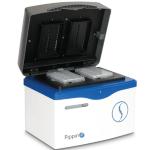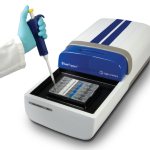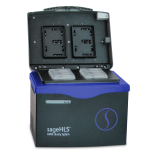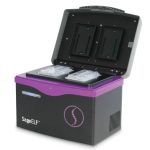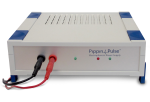ASMS Kicks Off, Honoring Mass Spec Luminary and Showcasing Cutting-Edge Proteomics
ASMS is underway here in Baltimore, Md., and the meeting has been so engaging that we haven’t even sneaked out to try some local crab cakes. The proteomics conference officially kicked off last night with a talk from Jason Kalirai from the Telescope Science Institute. The astrobiology- and astrophysics-rich presentation was out of the norm for this crowd, and had a palpable cool factor among mass spec scientists.
The first full day was Monday, featuring a program chock-full of concurrent podium sessions, workshops, and a poster viewing. As usual, life science is the best-represented area of mass spec use at this event, with session topics ranging from protein informatics and antibody development to biologic characterization and biomedical applications. Today’s award lecture came from proteomics pioneer Richard Caprioli, who is being recognized for developing MALDI imaging mass spectrometry.
Our team has really enjoyed the unusual setup in the exhibit hall, where we’re stationed in booth #67. As always, the ASMS exhibit hall is large enough to make attendees wish they had golf carts to get around, but this year the exhibitors and posters are interspersed in little islands, making it really easy to sample some of everything (including hot pretzels!). It’s nice being so close to posters that we can dash over and soak in some of the great science at this show.
There are hundreds of posters on display each day, so even with our wandering we only got to see a small fraction of what was available on Monday. One poster we found particularly interesting came from Neil Kelleher’s lab at Northwestern University. It focused on finding new ways to remove SDS, which is an important factor to our new SageELF workflow so it’s something our R&D team has been working on as well.
Speaking of which, if you haven’t stopped by to see the SageELF, please do so. We’ve had terrific conversations with the many attendees who have come to find out how this automated electrophoresis tool can reduce sample complexity, and we look forward to even more as the conference continues.
And now, if you’ll excuse us, all eyes are on the legendary hospitality suites tonight. After a long day at the conference, we’re looking forward to catching up with our favorite mass spec scientists in a more relaxing setting!
Coming to ASMS? Check out SageELF for Proteins
If you’re a proteomics scientist, chances are you may not have heard of Sage Science. We’re a small company aimed at improving sample preparation steps in the life sciences, and in the first several years we focused on DNA size selection.
As many customer studies have shown, our Pippin automated instruments for DNA sizing have proven to be the most reproducible and precise method for size selection in the next-generation sequencing workflow. (Check out these papers from Duhaime, Quail, and Peterson for examples.) In these studies, Pippin sizing beat out other automated methods as well as manual gel extraction, the most common selection technique.
Now we’re taking our expertise in gel electrophoresis and bringing it to the proteomics field, where we believe improvements in fractionation protocols could really boost the accuracy and precision of mass spec-based experiments. Protein experts who have evaluated our system say it will have great utility for bottom-up and top-down proteomics experiments, as well as any mass spec workflow using in-gel digestion.
We just unveiled our SageELF, short for Electrophoretic Lateral Fractionation, which can be used for whole-sample fractionation in protein studies. The instrument automatically generates 12 contiguous fractions from a protein sample and delivers them in individual elution wells. Run times take up to three hours, and two samples can be processed at the same time.
For more information, check out the SageELF product brochure.
Proteomics & Long-Read Sequencing, Together in Baltimore
Next week we’ll be heading south to Baltimore, home of the Orioles and Ravens, for two special events: the annual conference of the American Society for Mass Spectrometry and the Pacific Biosciences user group meeting.
The 62nd annual ASMS, to be held June 15-19 at the Baltimore Convention Center, will bring together thousands of mass spectrometry experts. We’ll be at booth #67 in the exhibit hall to show off our proteomic solutions: SageELF for whole-sample fractionation and BluePippin for targeted protein fractionation.
This year’s ASMS promises to be an excellent conference with a great cast of plenary and workshop presentations. We are particularly eager to hear from Vanderbilt’s Richard Caprioli, a MALDI pioneer who will give an award lecture based on his distinguished career in mass spectrometry development. Also of interest: Lucinda Cohen from Merck Research Laboratories will shed light on how mass specs are used in pharmaceutical research, and Erez Lieberman Aiden from Baylor College of Medicine will share insights on folding properties of genomes. Of course, the real meat of ASMS is always the oral sessions and workshops, where scientists exchange the best methods and technology applications. We don’t have enough expertise to fully absorb all the great details in these sessions, but we are looking forward to learning as much as we can!
On Tuesday, June 17th, PacBio will host its East Coast user group meeting at the University of Maryland, an event co-sponsored by Sage. We attended last year and were really impressed with the quality of talks, so we can’t wait to see what’s in store this time. In the past 12 months, more PacBio users have incorporated BluePippin to increase their average read length, so we are especially eager to see how much of a difference this is making. We’ve seen some projects more than double their average read length, a truly amazing feat given how long PacBio reads are to start with.
We hope to see you at ASMS or the PacBio event. If there’s a moment to spare, we might scoot out to enjoy Baltimore’s lovely Inner Harbor. Last year we stumbled upon a great gelato shop there, so if you miss us at our booth you may find us there!
SageELF for Spectral Libraries: An E. coli Example
Timing and proximity can work wonders when it comes to scientific collaborations.
As we were first developing the SageELF, a unique protein sample fractionation device, we discovered by chance that it fit perfectly into an initiative spearheaded by Jeff Silva of Cell Signaling Technologies — our neighbors here in Beverly, Mass.
At the time, Jeff and collaborating researchers from Gordon College, Waters Corp., and the Ionomix Initiative were interested in creating spectral peptide libraries for E. coli. The idea was to test a concept in which a comprehensive mass spec analysis of the E. coli proteome could be performed to provide researchers with a useful resource for future studies. With such a spectral library, the idea went, any protein scientist working with E. coli could do a preliminary scan, run a quick comparison against the spectra on the list and check those off, and then devote mass spec analytical resources to identifying proteins not in the library.
To get a comprehensive snapshot of the organism’s proteome, scientists at Gordon College, led by Dr. Justin Topp, created a “mega-sample” by growing E. coli under more than 60 different conditions, including growth phases, media types, and stress conditions. Then they extracted and pooled the proteins.
Enter the SageELF. The protein sample was separated by size into 12 fractions, upstream of trypsin digestion and LC/MS. This vastly reduced the complexity of the sample and allowed scientists at Waters to test the reaches of their analytical sensitivity.
After ELF fractionation, the sample complexity was even further reduced by a second dimension of separation (reversed-phase LC with the Waters nanoAcquity UPLC) before moving the samples to the Waters SYNAPT-G2S HDMS system to provide deep analytical coverage.
Of course, the name of game with complex mixtures is to find strategies for deconvolving isobaric peaks. Michael Nold, proteomics group leader at Waters, and Manor Askenazi of the Ionomix Initiative provided the software and analysis expertise to tackle the challenge.
How did we do? The team estimated that we identified up to 80 percent of the E. coli proteome — not bad for a first shot. For our part, we feel the SageELF could do much better now that development has been completed; we are getting much better separation in the fractions (i.e. less overlap in adjacent samples). If you’d like to check out the scientific poster we presented at 2013’s ASMS, you can view it here.
We’d like to thank everyone on the team, especially Jeff, for working with us and giving us the opportunity to demonstrate the SageELF. Since we got so much out of this serendipitous neighborhood encounter, we’d like to make sure everyone knows about another great local networking opportunity: the Life Sciences Consortium of the North Shore (of Massachusetts). Our founder and board member Gary Magnant was instrumental in creating this consortium, and we hope that it helps other companies have the same kind of luck we had with Jeff and his team.
Growing Up, Moving Out
Exciting times here at Sage Science — we’re moving! We’ve outgrown our current space and will be heading to offices that provide about 50 percent more room for our sizable team. We won’t even have to learn new commutes, as the new space is just downstairs from our old office.
Aside from the extra elbow room, the move is exciting because we’ll have all of our operations in one central space, bringing manufacturing into the same location as the rest of our team for the first time. We’re proud of the fact that we build all of our instruments right here in Beverly, Mass., and it’ll be great for the whole team to see the flurry of activity as new boxes are assembled, tested, and shipped to customers.
The move comes at a time when we are expanding into new markets. Thanks in large part to stellar work from our customers, our Pippin Prep and BluePippin instruments have become the accepted standard for automated DNA size selection, particularly in the NGS space. Now we’re taking our fractionation expertise to the proteomics realm, where automation, precision, and reproducibility can improve results from top-down, bottom-up, and other mass spec workflows. Our new SageELF performs whole-sample fractionation for proteins and DNA, and the BluePippin has been outfitted with fancy new cassettes that allow it to do targeted protein selection.
If you’re ever in the Beverly area, we hope you’ll stop by for a tour of our new digs.
